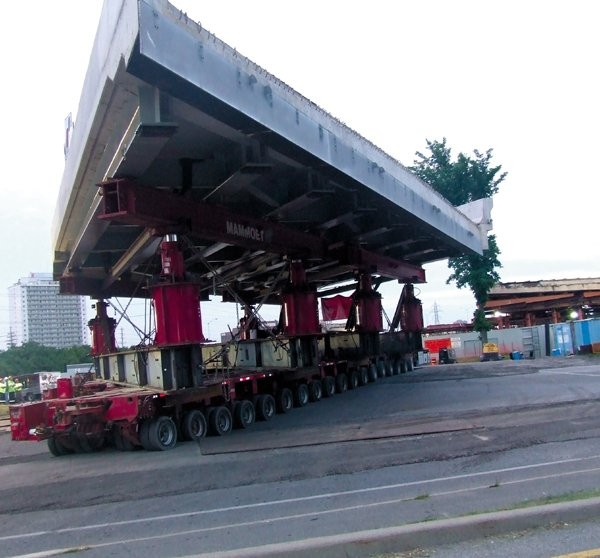Self Propelled Modular Transporter speeds bridge replacement in Ontario

Rapid bridge replacement uses a computer-controlled, Self Propelled Modular Transporter (SPMT), similar to the technology used to move NASA’s space shuttles. The SPMT is a specialized piece of equipment with many axles. It lifts and carries away the old bridge and then another SPMT moves the new structure into place.
Rapid bridge replacement can be done in a matter of hours versus conventional bridge replacements on urban highways which usually take nine to 12 months to complete. The conventional method involves extensive and costly traffic staging with temporary barriers, lane markings, work zone signs, and lane and shoulder width reductions. Rapid bridge replacement significantly minimizes traffic disruption and congestion.
The Ontario Ministry of Transportation (MTO) started using this construction technique for single-span bridge replacements in 2007, beginning with the bridge at Island Park Drive on Highway 417 in Ottawa.
Recently, they used this technique to replace the Carling Avenue Eastbound Bridge in Ottawa on Highway 417 in just 15.5 hours.
The Carling Avenue Eastbound bridges were constructed in the Saigon Court staging area next to the Queensway. There were two bridges, one for the Highway 417 eastbound direction and one in the westbound direction.
The new bridges are 21 metres long and the eastbound bridge is 21 m wide while the westbound bridge is 30 m wide. The weight of the heavier bridge is approximately 700 tonnes.
A North American first
The first multi-span highway bridge to be replaced in North America using rapid bridge replacement technology was the Aberdeen Avenue Bridge in the City of Hamilton, Ontario.
The Aberdeen Avenue Bridge was originally built in 1963, as a four-span continuous bridge with spans up to 25 m and a conventional multi-span concrete deck on a steel girder structure. A 2008 ministry bridge condition survey along with a life cycle cost analysis determined that the bridge deck and superstructure, including girders, diaphragms and bearings, needed replacement, along with some rehabilitation to the substructure.
Managing existing traffic is one of the biggest challenges facing freeway bridge rehabilitation projects in Ontario. Certainly, the main reason the ministry considered the Aberdeen Avenue Bridge as a candidate for rapid bridge replacement, was its potential to minimize traffic disruption to the busy Highway 403. As Aberdeen Avenue is an important access point to Highway 403 for commercial, industrial, institutional and residential traffic, a rapid replacement strategy would benefit the City of Hamilton. In addition, an accessible area was located nearby that could be used for project staging, equipment, and prefabrication of the new bridge structures.
Using experience gained from its two previous large rapid replacements, the ministry’s project team carefully planned an hour-by-hour schedule for the entire weekend of the Aberdeen Bridge replacement. Leading up to the event, the new bridge deck sections were prefabricated in the staging area, complete with girders, deck, barriers, and waterproofing.
Beginning at 9 p.m. Friday on the August 2010 Civic Holiday weekend, the main lanes of Highway 403 were closed and traffic was detoured around the Aberdeen Avenue Bridge. Upon closure, the two interior spans of the old bridge, weighing 500 tonnes each, were separated from the bridge piers, lifted and rolled away one at a time on the Self Propelled Modular Transporter to the staging area for demolition. Meanwhile, another transporter moved the new middle spans into place, lifting them onto the renovated piers by early Saturday morning. Highway 403 was re-opened to traffic by 8 a.m. that morning. Aberdeen Avenue remained closed while construction crews continued to work on the end-sections.
The old end sections were saw-cut and lifted out with large cranes on Friday night and Saturday morning during the transporting of the middle sections. The new end-sections, prefabricated units constructed on temporary platforms immediately adjacent to the bridge, were slid laterally into position by jack and slide technology. The jack and slide operation involved hydraulic jacks which pushed the new sections into place along tracks installed under the sections during construction.
Once all spans were in place, concrete was poured to connect the four spans together, completing installation of the new structure by Sunday afternoon. Workers began paving the new bridge by Sunday evening, then installed road signs, applied pavement markings, and performed a general cleanup Sunday night.
The new Aberdeen Avenue Bridge re-opened to traffic early Monday morning without a hitch and well ahead of schedule.
From the time Aberdeen Avenue was closed and re-opened; the entire replacement operation took just over 51 hours, far less than the 80 hours allotted for closure.
Old and new spans were transported over a period of about nine hours and end-section jack and slide operations were completed in about four hours.
Using the rapid bridge replacement method provided several significant benefits to road users, construction workers, the local economy and environment.
Extensive outreach
It should also be noted that MTO implemented an extensive outreach and educational program that provided live coverage of the replacement while underway. The replacement was videotaped around the clock, along with a website link on the MTO public site, to allow the public to view the replacement live during the August long weekend. Ministry staff also used Twitter to post tweets reporting the progress of the work throughout the weekend, as another way to follow the replacement in real time.
In addition, the ministry constructed a public viewing area for spectators to view the replacement from a safe distance without impacting the contractor’s operations. MTO has developed an informational video and literature from the coverage to use for future promotional and training purposes.
Opportunities
Ontario owns and maintains more than 2,700 bridges. Opportunities for rapid bridge replacement depend on bridge design and size, clear cost savings and availability of a nearby site to build the new bridge.
Acknowledgement: Material and photos (copyright 2012) provided by the Ontario Ministry of Transportation.

